WAR FOR THE PLANET OF THE APES: The End of Mankind Never Looked So Good
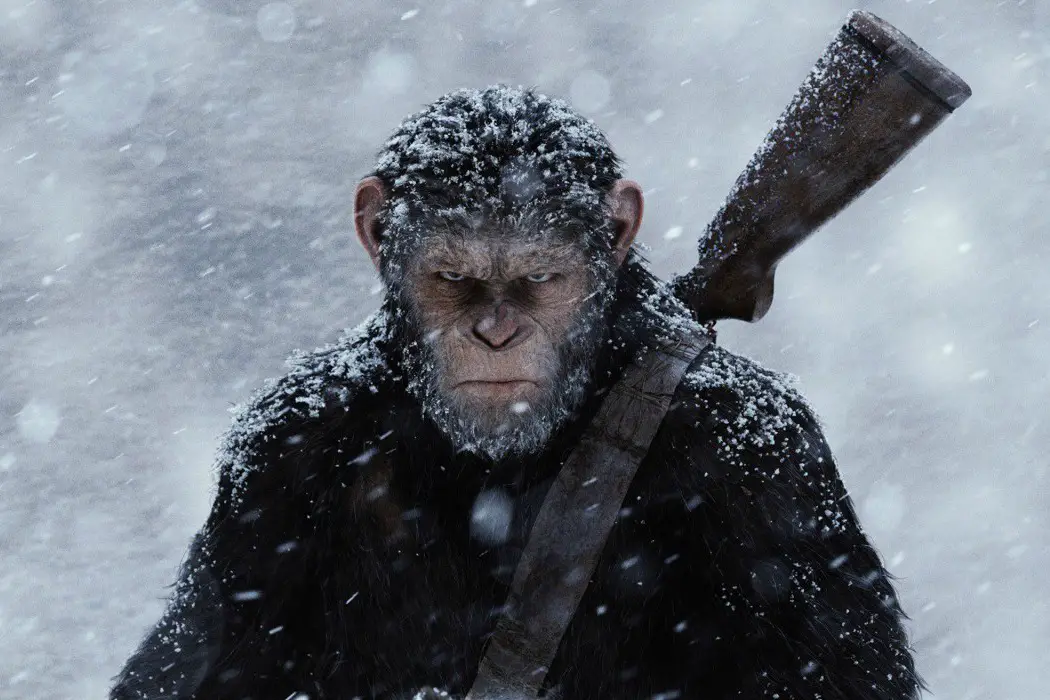
Stephanie Archer is 39 year old film fanatic living in…
Picking up 15 years after the initial spread of the virus, War for the Planet of the Apes begins with the remaining survivors of mankind fighting a war against both natural selection and Caesar’s colony of intelligent apes. With two highly successful films behind him, the pressure was on for director Matt Reeves to deliver the same kind of quality, story, and cinematic achievement as before. With War, he once again delivers a compelling story that will satisfy fans of the franchise old and new.
With the release of War for the Planet of the Apes comes an even deeper appreciation and widespread knowledge of the technological achievements that have been made and can be made using live-motion capture. There has been an outpouring of praise for actor Andy Serkis, not only with regards to his performance but for the Performance Capture technology that his company (The Imaginarium Studios) has single-handedly made a vital aspect of filmmaking, as well as advancing the possibilities for film and actors alike. With this in mind, War for the Planet of the Apes may bring a special recognition award for Serkis for his contributions from the Academy – an acknowledgement that has long been missing.
War For The Planet Of The Apes
War for the Planet of the Apes begins with a quick and cleverly laid out recap of the previous films, as human soldiers covertly make their way through the Red Woods. Caesar (Andy Serkis), having not been spotted for some time, is believed to be either dead or in hiding for fear of assassination. Trust between Ape and man has forever been severed and only fighting has remained between them. They each know, on some level, that only one species can remain supreme, and the ultimate core of their fight is to stay alive and on top.
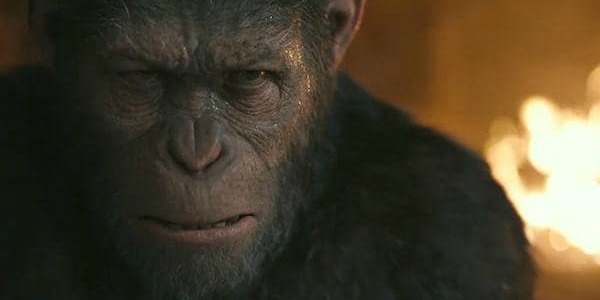
Finding little success in a surprise attack on an Ape hideout, the surviving soldiers find themselves face to face with an angry and grieving ape colony – and the final judgement of Caesar (who is in fact alive and well). Finding an opportunity to show mercy and possibly end the bloodshed between them, Caesar decides to spare the lives of the men – sending them as a message to the renowned Colonel (Woody Harrelson). Yet, where Caesar still has his sensibilities, the Colonel does not.
As the Apes sleep on a plan to relocate, the Colonel brings the fight to them – making a move on Caesar that will leave him changed forever. With the answer to his message fully answered, Caesar comes to the final realization that he must protect only Ape and put an end to the Colonel once and for all. While his colony leaves for their new home, Caesar (with the help of his closest comrades) embarks on an unflinching journey that will put his values in question, his life in jeopardy, and change the future of the apes forever.
The Specs
The release of War for the Planet of the Apes has been meet with an outpouring of praise for its continued visual achievements and epic story – and I must say, the film lived up to the hype. From the visuals to the storyline to the acting, everything was on point and culminated in a successful conclusion to the remade and re-envisioned prequels. The film finally answers every question that the original films forever left unanswered – well with the exception of one, but I don’t want to spoil that for you.
Visually, War for the Planet of the Apes is dynamic, the motion capture filming a front runner as the face of the evolution and possibilities of movie magic. While I had known this technology existed, and had seen several films utilizing it, this was the first film that forced me to step outside of the story and really examine the beauty. While the use of this technology was a decision that originated in the first film, Rise of the Planet of the Apes, it has only become better and better with each new installment. It is further enhanced by the carefully crafted decisions by director Matt Reeves to bring it to its full potential.
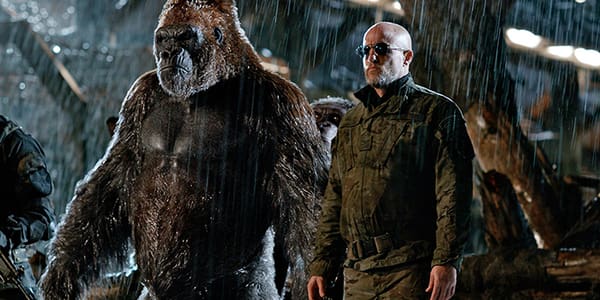
Yet, it is not just the magic of how War was filmed, but also what the visuals represent. At its core, this is a film about fear and brutality. The scenes and filming at several times throughout are visual representations of natural selection and the destructive power of mankind (and at times, ape-kind). The structures of the scenes and the selected shots, as well as the environment and situations the characters are placed in, were beautifully crafted and executed by Reeves to bring these core elements to fruition.
With regards to the film’s story, there is a beautiful continuity that wraps up the prequel trilogy in a nice bow that will satisfy fans and movie goers alike. War finally answers the question of what happened to mankind, fully bringing a true understanding to how the end of the human race as we know it came to be. The script from Mark Bomback and Matt Reeves, brings an engaging finality to the prequel setting, laying pieces of the original films (some more obvious than others) as a homage and a platform for the possibility of future installments.
The script for War for the Planet of the Apes also moved at a faster and less stagnant pace than the second film, Dawn of the Planet of the Apes, providing more engagement for its audience – yet I was still annoyed with the lack of dialogue. I had expected the apes to have advanced further in their acquired intelligence, yet their communication was still largely limited to sign language. It is in this lack of progression that I found the film to be at its weakest.
While you may have a great story and captivating visuals, you need a solid cast to bring everything together – something War found further success in. Woody Harrelson is his usual self, bringing the same arrogance and savvy to his character – yet there is an addition of obsession and intensity, coupled with sadness, that only he could encompass and satisfy within his character. Steve Zahn, whose Bad Ape is the comic relief of the film, shines through the motion capture visuals, his voice and nuances that have found him success in previous roles adding charm and charisma to this newly discovered ape.
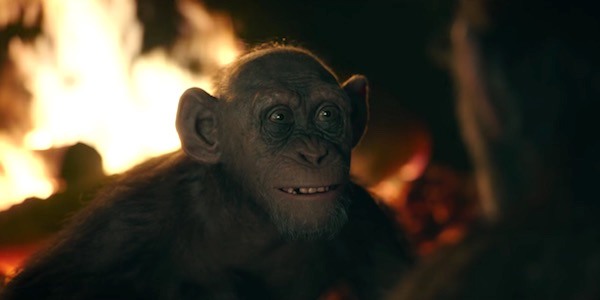
Yet, where everyone was a perfect match, Andy Serkis continued to wow with his third run as Caesar – the leader of the intelligent apes. Serkis has been receiving acclaim for years for the various roles he has portrayed and the motion capture used to bring these characters to their full form – and this film was no different. His performance within War for the Planet of the Apes lives up to the hype, his unique and talented ability to encompass a character with every muscle of his body and face radiating through his performance – a talent that has shockingly been unacknowledged by the Academy.
In fact, there has been a substantial building of support throughout the industry for him to receive the Special Achievement Award from the Academy of Motion Arts and Sciences for his significant contribution to the film industry – a recognition that has not been awarded since the release of Toy Story. While it would not be a direct acknowledgement for his acting ability, it would be an all encompassing nod to his achievements in film.
Fingers crossed!
The Brutality of Fear
One of the most fascinating and saddest parts of War for the Planet of the Apes was the constant reminder of how brutal an individual (or Ape) can be when they are in the face of fear. This fear and brutality is presented on many levels throughout the film and through different characters within War. With this examination of fear and brutality, War continues the continuity of the previous films, building on the topic of trust that was thoroughly examined and destroyed in the second film, Dawn of the Planet of the Apes.
“Donkeys” as they are named by the human military, are the surviving apes of Koba’s mutiny against Caesar from the second film. Through fear of what will happen to them for their betrayal, and a burning fire of hate towards Caesar, they ally themselves with the human military. Their fear leads to their brutality on fellow apes, and serves as a means to comfort their inner conscience. Yet, when we look at the bigger picture, the treatment of these traitorous apes shows that no matter the loyalty or side an ape chooses, they will always be a threat and a bug to be squashed in the eyes of humans – a brutality extended to ape through a driving fear in mankind.
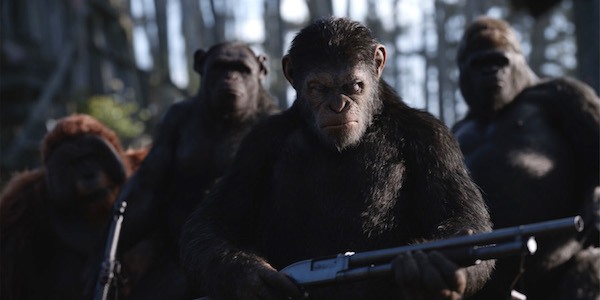
Caesar and his apes fight for fear of being wiped out and defeated by the increasingly desperate human race. With each trial and tribulation, they find themselves becoming more like the brutes that they have fought in the past and continue to fight in the present. Yet, there is also fear of those apes that have turned against them, leading the apes down their own path to brutality.
Yet, mankind, still clinging to the title of superior species, displays the greatest brutality as a result of fear – fear of being taken off the top and fear of a lack of control. Mankind is staring down the barrel of their inevitable annihilation – in more ways than one – and they will do anything in their power to stop it. They cannot control nature or the consequences of the man-made virus that has been unleashed, so they fight back to regain control and wipe out those who stand to replace them.
Conclusion
War for the Planet of the Apes is a film fans of the Apes saga, and newfound fans of the prequels, will find as a satisfying addition to the series. And believe the hype. It is a visually stunning achievement, with a story carefully crafted to bring a believable continuity to the saga and round out an even finish that honors the original. With solid performances to finish out the film and its characters, this is a film that will not soon be forgotten.
War for the Planet of the Apes was released in the United Kingdom on July 11, 2017 and the United States on July 14, 2017. For all international release dates, see here.
Does content like this matter to you?
Become a Member and support film journalism. Unlock access to all of Film Inquiry`s great articles. Join a community of like-minded readers who are passionate about cinema - get access to our private members Network, give back to independent filmmakers, and more.













